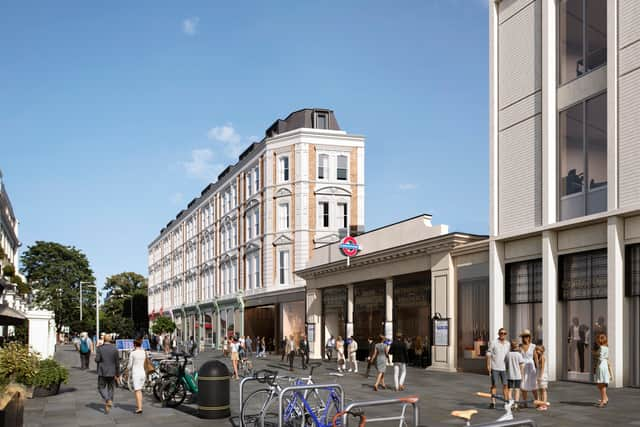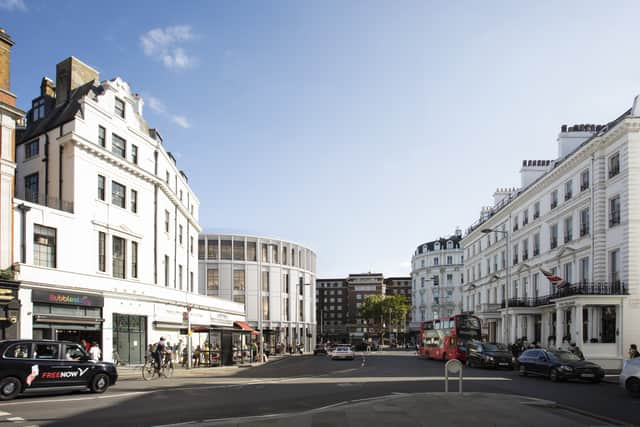TfL bid for development at South Kensington Tube station redevelopment gets go-ahead
and live on Freeview channel 276
A west London council has lost a bid to stop a mixed-use office block and row of flats being built around South Kensington station and warned developers against “ploughing on” with the project.
Kensington and Chelsea councillor Cem Kamahli said the Planning Inspectorate’s decision to overturn the council’s refusal was a “blow” to the more than 2,000 people who opposed the scheme.
Advertisement
Hide AdAdvertisement
Hide AdOn Tuesday, Britain’s top planning body partially approved plans by Transport for London (TfL) and developer Native Land to build 50 homes and a four-storey building known as ‘The Bullnose’ around the Grade-II station, bringing a reprieve to a long-running dispute with Kensington and Chelsea Council, which blocked the proposals in 2021.
The scheme, designed by architect Rogers Stirk Harbour + Partners, includes the bulldozing and rebuilding of the Bullnose at the front of the station, refurbishing flats and shops along Thurloe Street and new homes on Pelham Street.
The Inspectorate knocked back plans for two retail façades in the underground pedestrian passage linking the station with museums on Exhibition Road saying the design clashed with the heritage-tiled appearance of the subway.
Cllr Kemahli said though he recognised the station needed development, the one being proposed allegedly risked ruining South Kensington’s “recognisably distinctive and much-loved character”.
Advertisement
Hide AdAdvertisement
Hide AdThe lead member for planning and public realm said: “This decision by the Planning Inspectorate is a disappointing blow for people who live in the area, against our planning committee’s decision. TfL even worked on design principles with residents earlier in the process which have also been contradicted in the final designs for this development.
“Instead, TfL is ploughing on with a scheme which is opposed by more than 2,000 people.”


He urged TfL to fully fund step-free access at the station before ripping into designs for the Bullnose on X. He wrote: “We had a welcomed classical alternative to the proposal but now we must suffer this glass slab.
“We have long wanted TfL to make South Ken [sic] step free, acknowledging some form of development would be necessary to raise funds – but rather than apply for the scheme mutually agreed, they put forth a plan we believe harms the historic area. The glassification of London continues.”
Advertisement
Hide AdAdvertisement
Hide Ad

Alasdair Nicholls, chief executive of Native Land, said the decision “brings a drawn-out planning process to a positive conclusion”. He said: “This is a high-quality scheme that will protect the heritage of the station while bringing a renewed sense of place to South Kensington. When complete, it will create an experience befitting the gateway to London’s internationally renowned museum and cultural quarter.”
A TfL spokesperson said it is committed to delivering station capacity upgrade works at South Kensington and will begin discussions on raising funds for the project.
The council blocked the development in November 2021 citing concerns about the height and impact of the proposal on the local conservation area. TfL and Native Land appealed the decision and an inquiry was held between January and May this year.
In its decision, the Planning Inspectorate said the Bullnose could be redeveloped because the heritage listing made clear it was not of any special interest and said the proposed height of the new building was not out of scale with the area. They said flats along Pelham Street would replace previously demolished homes and that the refurb of flats and shops to the north caused “less than substantial harm”.
Advertisement
Hide AdAdvertisement
Hide AdHowever, the planning body ruled TfL and Native Land could not start the development until they could show they had sufficient funds to carry out the step-free access works. It said step-free access had to be provided before the Bullnose was demolished.
The BBC’s Local Democracy Reporting Service understands there is a six week window during which time the decision can be challenged in the High Court.
Comment Guidelines
National World encourages reader discussion on our stories. User feedback, insights and back-and-forth exchanges add a rich layer of context to reporting. Please review our Community Guidelines before commenting.